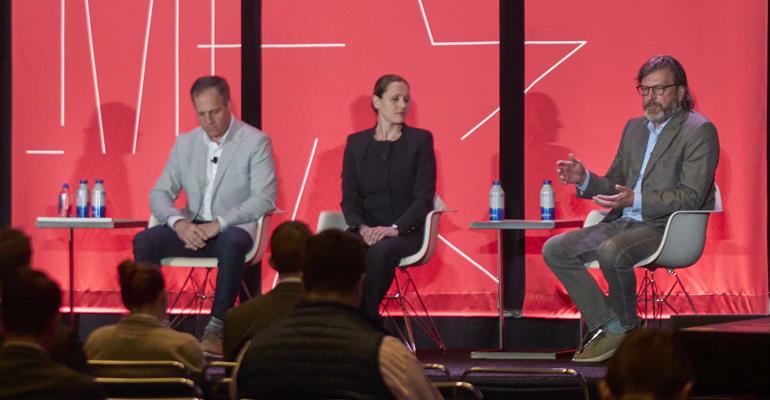The combination of 2022’s rough results for the traditional 60/40 portfolio along with the proliferation of alternative investments is producing a debate on portfolio construction that played out during the Morningstar Investment Conference in Chicago.
A session featuring Joel Dickson, Vanguard’s global head of advice methodology; Philip Green, BlackRock’s head of global tactical asset allocation team; and Catherine LeGraw, GMO’s asset allocation specialist, explicitly took up the question of whether the traditional 60/40 portfolio is dead.
Green called the 60/40 strategy “bloodied,” but defended its long-term track record and Dickson pointed to 2022 as an aberrational year with bonds and stocks both posting negative returns—a scenario unlikely to be repeated. LeGraw, meanwhile, said the 60/40 strategy is dead and argued for the inclusion of liquid alternatives rather than traditional bonds in client portfolios.
“There are a lot of wonderful assets that are not represented in a traditional 60/40 portfolio,” LeGraw said. “If you are using the Bloomberg aggregate bond index, there are many credit assets not represented. Things like securitized debt or high-yield bonds. … The market can serve up wonderful opportunities to take a different position in your portfolio.”
Green argued that diversification is possible in a 60/40 portfolio without moving to alternative assets, although he did think an allocation of up to 10% for alternatives could be reasonable for some investors in lieu of bonds.
“You can shift some of that 60% portfolio to less interest-rate sensitive stocks, for example. Another thing you can do is diversify that 60% so it’s not all just U.S. stocks. … If you had all 60% all in U.S. equity last year, you were hit [but if you] diversified into Europe or Japan it would give you diversification to what happened in the U.S. You can diversify across inflation regimes.”
As for true alternatives, “if you are getting into private assets [you have to make sure] to do that at a reasonable fee or liquid alts at a reasonable fee. But if you start moving into liquid alts, make sure the diversification is really there. … Just understand what you’re getting into. You can do better than 60/40, but it gets complex and you have to understand what you are stepping into and what your client is stepping into.”
Dickson echoed that caution.
“I’ll agree that there may be role for a strategic allocation to privates for those that can access it and do it at a reasonable cost to capture a premium,” he said.
A separate session took up the question of alternatives explicitly with panelists acknowledging that the wide variety of asset types and structures is one barrier to overcome for investors and advisors.
“Where they fit into portfolio construction [will be helped] by all of us defining what area of the alts business we participate in,” said Tara York, head of strategic partnerships, Luma Financial Technologies.
Luma, for example, focuses on capital markets based alternatives, including annuities, structured notes and market-linked CDs. In modifying the 60/40 model, “we can look at alts, specifically structured products, as a risk management tool. … Often we focus on return—and we need to—but we also need to focus on risk. And structured products are one of many alts that are crucial to building out a holistic portfolio.”
“The general awareness of private markets [among retail investors and advisors] is all very low,” said Michael Kell, senior vice president, education strategy & programs with iCapital. Institutional investors are more exposed to private investments, Kell said. “What I would argue, is who needs those returns? Retail investors needs them.”
To that end, Kell said iCapital’s goal is to provide education and analysis on alternatives assets and structures for advisors and retail investors. “There’s not a global asset manager right now that’s not hiring to build out in the alternatives space,” he added. “That tells you that’s where the money is going.”
For example, PIMCO launched a real estate interval fund this year as part of its offerings in the alternatives space. PIMCO CIO Dan Ivascyn said the level of uncertainty and volatility in markets is part of why alternative investments could be attractive for investors, he said.
“You have much less synchronized economic cycles (between countries). There is a lot of uncertainty in fundamentals. You have less liquid markets. There are fewer banks providing liquidity. That’s a darn good environment for relative value trading,” Ivascyn said. “We have the same view on credit relative value. You don’t have to be exposed to directional risk. There’s a great opportunity to shift beta exposures into more liquid relative value segments of the market. … Within the directional area, it could be interval funds, it could be non-traded products, private credit, real estate, etc. Here we think investors should be patient in their deployment of capital.”
Other options are digital assets, such as cryptocurrencies and tokenization. But as with other alternatives, education is a barrier that providers are trying to overcome.
“Learning digital assets is very different than traditional assets,” said Hashim Mirtha, CEO, MeetAmi. “It’s evolving quickly in terms of the technology, regulation and compliance. … A big focus for us is education of advisors on how to have this conversation with their clients. … It is critical that advisors catch up to retail clients. As time evolves, there will be more digital versions of traditional investments. Now is the opportunity for [advisors] to get up to speed.”





